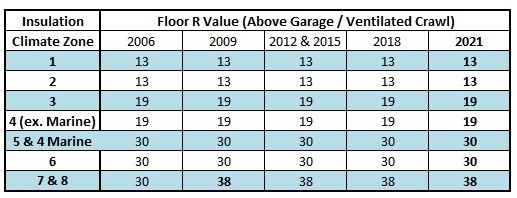At Alamance Insulation and Gutters, we’re a leader in the insulation and home performance industries. Serving customers throughout North Carolina, from Greensboro, Burlington, Elon and Mebane to , Durham, and Raleigh, we can help with all your insulation and gutter needs. We’re expecting a cold winter this year, and your gutters and insulation could be at risk. For all your insulation and gutter needs – in winter or otherwise – contact Alamance Insulation and Gutters today. We’d love to help!
The International Energy Conservation Code (IECC) has released requirements for insulation for 2021. From the Homeowners and Trades Resources Center, here’s a helpful guide on what to expect regarding insulation in 2021:
One common question many people ask is, just how much insulation should I have or use for XY or Z? This generally gets followed up by what type, is more better, how about diminishing returns, and the list goes on…
On the flip side, most of those that have building homes for quite a while have stopped asking as there hasn’t been a significant change since the 2012 codes came out. Shoot some items haven’t changed since the 2006 version came out & I grew up with some of those numbers. Well that is about to change with the 2021 codes as everyone gets at least one if not more changes coming at them.
Ceiling Insulation:

Can you say R 60? For climate zones 4 & up they are going from an R49 to 60 which is approximately another 3″ of depth. Climate Zones 2 & 3 are also increasing another R11 from an R38 to 49. For many this will necessitate going with larger raised heel trusses. To our knowledge the 500 SF insulation step down exception is still there BUT that would be from the new numbers so you either have to pack another R11 into the same space (not happening if vented), use a different product, or increases the space by 3.” Along those lines & unfortunately they still have not addressed the Hot Roof / Encapsulated Attic issue which we will cover in a follow up piece.
Wall / Rim Insulation:

First the only big increase applies only to climate zones 4 & 5 with everyone else staying the same. For Climate Zones 4 & 5 they now have to add “Exterior Continuous Insulation” no matter what. For those with 2×6 walls using foam or dense packed cellulose they now have to add R5 to the exterior (sorry there is no R20 fiberglass product yet – read the package). For those with 2×4 walls they have gone from R5 to R10.
With that all climate zones now has an interesting tweaks / option available which has many of us saying “finally.” Now instead of “swallowing the sweater” you have the option of using ONLY continuous insulation on the exterior. For CZ 1 &2 they can use R10, R15 for CZ 3 – 5, and R20 for CZ 6 & up. Yes you read that right, you don’t have to put insulation in the wall cavities if you go this route which eliminates a ton of issues & getting better performance.
Floor Insulation:

Yeah nothing has changed on this since 2009 when CZ 7 & 8 went from R30 to R38… Floor insulation essentially only applies to those with unconditioned basement’s, ventilated crawlspaces, rooms above garages (other unconditioned spaces), and cantilevers (?). Why the question mark – well as I have mentioned before the codes are black and white – with a whole lot of gray. While this is technically part of the floor, should it be treated that way or as part of the wall. What about the “rim” portion? Generally you will be fine if you treat a cantilevered section as part of the floor BUT make sure it is continuous wrapped up to connect with the “wall” & if you are using continuous insulation it needs to cover the exterior vertical portion of the “rim” as well.
Basement & Crawl Space Walls:

There have been no increase to this one either since 2012 but, they did add in an Option for those with basements only in CZ 5 – 8 (okay & Marine 4). Now you can have R13 inside as long as you have R5 outside instead of having to do R15 exterior only or R 19 batts. Basically this allows for 2×4 framing to be used for exterior basement walls instead of 2×6’s.
Windows aka Fenestration:

Please note that while this doesn’t really count as “insulation” it is a big factor (as windows account for at least 8% of the walls exterior) & one that they love tweaking each cycle. While they did change some of the values somewhat this time, there should be no issues for anyone finding windows that meet these specs as .30 .30 windows are a dime a dozen with most exceeding these targets without doing anything special. For those with a lower SHGC rating, that generally means just adding a Low E coating & you’re done. BS4D: NFRC Labels (Windows, Doors, Skylights)
